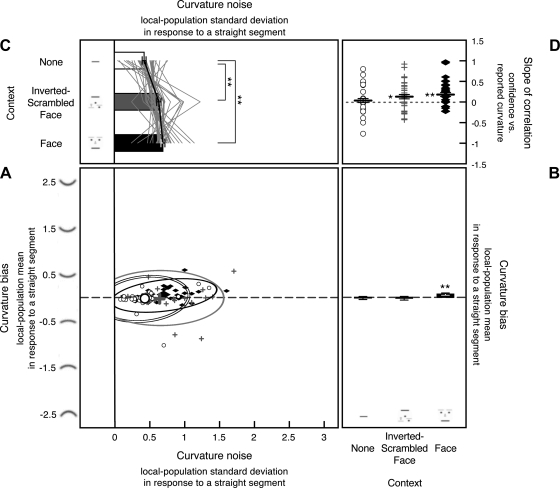Fig. 4.
Internal curvature bias (i.e., the Gaussian mean of the curvature-channel population output) and noise (i.e., the Gaussian standard deviation of the channel-population output) in response to a straight segment estimated from 8-stimulus curvature-absent trials in experiment 1, shown along with the slopes for the correlation between reported curvature and confidence. A: scatterplot showing each observer's internal curvature noise (x-axis) and curvature bias (y-axis) from each condition, with open circles showing estimates for the no-context condition, gray “plus” symbols showing estimates for the inverted-scrambled-face condition, and filled black diamonds showing estimates for the face-context condition, with corresponding 95% confidence ellipses. Large circles, plus symbols, and diamonds indicate the group means for the 3 stimulus conditions. The dashed horizontal line indicates no curvature bias. Note that, although the scatterplot shows data for all observers, the consistent effect of stimulus conditions on the magnitude of curvature noise is obscured by the relatively large individual differences in the baseline levels of noise (see main text for details). B: the y-dimension of the scatterplot (estimated internal curvature bias). Because there was little perceptual bias across all stimulus conditions, only the group means (bar graphs) are presented with the error bars representing ±1 SE. C: the x-dimension of the scatterplot (estimated internal curvature noise) presented as a line graph per observer with each observer's overall mean aligned to the group mean to show the consistent condition effects. The accompanying bar graphs show the group means with the error bars representing ±1 SE (adjusted for repeated-measures comparisons). For the 2 observers whose noise magnitudes could not be precisely determined for the no-context condition, we used the maximum noise estimates (see methods for experiment 1 for details). D: slope of the correlation between reported curvature and confidence shown for each observer for each stimulus condition (note that incidences of similar slopes produced overlapping symbols, giving the impression of missing data). The black horizontal bars indicate the mean slopes with the error bars representing ±1 SE. For A–D, **P < 0.01, and *P < 0.05.

